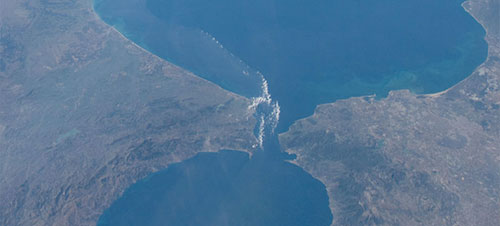The Security Edge: Part Five of a Seven-Part Series on the Ocean Edge
This week we continue our 7-part series with a discussion about the natural security provided by the ocean edge: the barrier effect of mangroves, beaches, cliffs, bluffs, atolls and more, and the ways that these places became and remain military and defense installations for protection of national interests. The Security Edge is part 5 of a 7-part series dedicated to the ocean edge, exploring what takes place there, from the real to the symbolic.

For the last four weeks we have been discussing the edge, where the land meets the sea — the hard edge, the soft edge, the working edge, the leisure edge — various perspectives brought to bear on this most dynamic place. But what about the security edge? What does the specific configuration of the coast provide to protect us from natural and human interventions?
The most obvious response is of course the barrier effect: the curvature, inclination, geology, and natural configuration provided. Simply by the shape of the land we are protected from strong wind and angry wave. The points of land and sheltered coves, the beach and barrier dunes, the mangrove swamps, the rocky cliffs and bluffs — all these contribute to the security of human settlements there. In many cases, we have exploited those features to site our cities and settlements. We have, for example, extended protections through breakwaters and engineered port facilities or developed certain beaches as resorts and recreational opportunity.
We have also destroyed many of those features — blasted artificial ports, removed and filled the mangroves, dredged the natural river outlets, and created coastal features and constructions that modify and erode rather than sustain the coastal zone. As extreme weather events increase and as the sea level rises, these man-made artificial features are challenged and proven short-sighted with now resultant serious social and economical disruption.
Another important aspect of the security edge is defense against military attack. Ports become targets; beaches become likely places for attack; bluffs and outcroppings become sites for observation and artillery; coastal features become logical places for bunkers, lookout towers, radar placements, and other structures for invasion defense. Historically, one can see the ruins of these installations — old forts overlooking coastal cities with rusting cannons as physical memorials to transformational battles and events. The narrow entrances to the Baltic Sea at Oresund and Mediterranean Sea at Gibraltar are such important historical places, where access was limited, tolls collected, and passage surveyed, even prohibited, as an expression of political and economic power and potential.
It is no different today, really. The coast is still the only place for naval construction, bases and fleet stations, submarine pens, missile launch sites, and global communications towers and links to orbiting satellites. Key topographical places are often in the news, passages through which concentrated shipping must pass; a global network of narrow ocean places where movement is confined between two coasts and vulnerable to adjacent military surveillance and attack.
We must remember that for all time — from Odysseus to today’s tension in the China Sea — the ocean has been a vast earthscape for naval operations, imperial expansion, offensive and defensive conflicts, and the exercise of national interests. Almost all developed nations have some level of a naval fleet to patrol and police their territorial water against smuggling, piracy, and illegal fishing practice. The larger geopolitical players — the United States and Russian Federation, for example– have massive investments in surface and submarine vessels that are constantly at sea as part as a tactical game of influence. Growing economies like China and India are engaged in an expensive expansion of technology and capacity to compete on the world ocean for strategic advantage; another version of the arms race with certain implications for future control of the sea.
All this may seem invisible and disconnected from how we understand and view the edge. But it is real and significant; security is very much part of what is a multi-layered interpretation of what it means to live alongshore where the land meets the sea, a sharp edge that is both useful and dangerous.
- - -
PETER NEILL is founder and director of the W2O and is author of The Once and Future Ocean: Notes Toward a New Hydraulic Society. He is also the host of World Ocean Radio upon which this blog is inspired.
- Login to post comments
-


